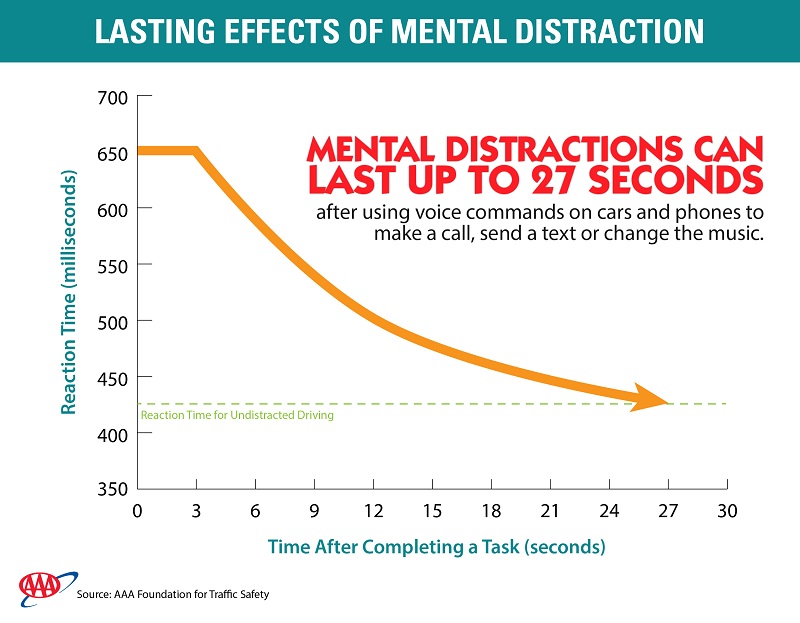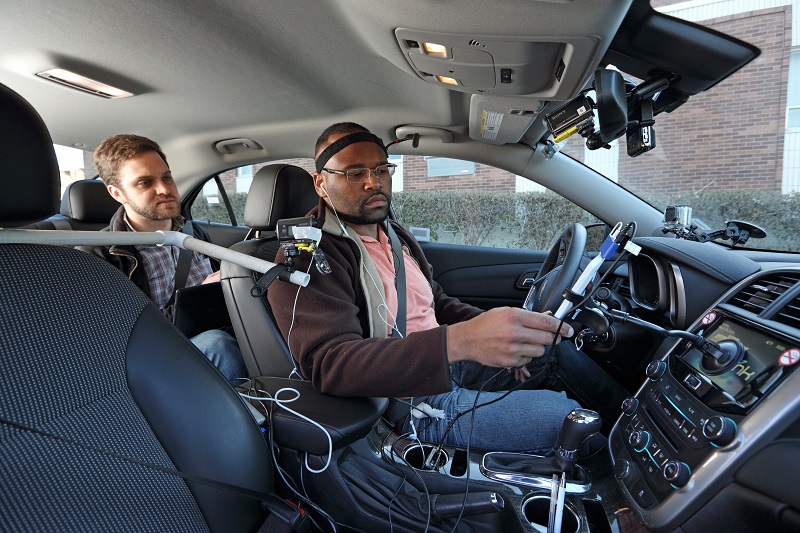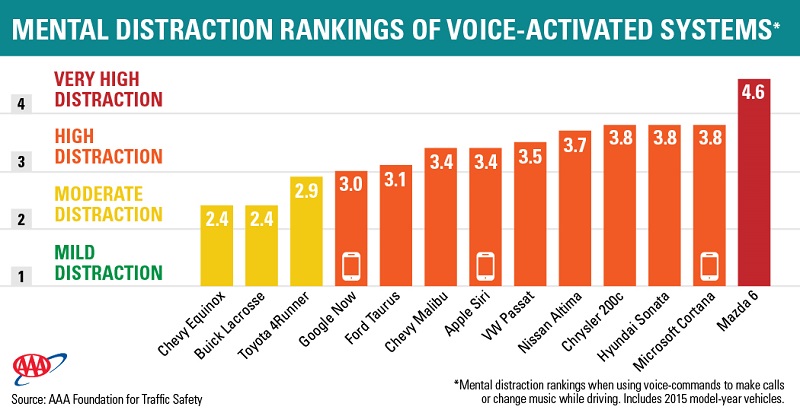While voice command technology is supposed to enable today’s tech savvy community to better multi-task, a pair of studies by researchers at the University of Utah indicates the capability is actually more of a distraction than anything.
In fact, the technology holds an individual’s attention for nearly a half a minute after a voice command has been issued.

The research, which was done on behalf of the AAA Foundation for Traffic Safety, made two noteworthy findings:
• It is highly distracting to use hands-free voice commands to dial phone numbers, call contacts, change music and send texts with Microsoft Cortana, Apple Siri and Google Now smartphone personal assistants; it is worth noting though, that Google Now was found to be a bit less distracting than the others.
• The other study examined voice-dialing, voice-contact calling and music selection using in-vehicle information or “infotainment” systems in 10 model-year 2015 vehicles; three are rated as moderately distracting, six are highly distracting, and the system in the 2015 Mazda 6 is very highly distracting.
“Just because these systems are in the car doesn't mean it's a good idea to use them while you are driving,” says University of Utah psychology professor David Strayer, senior author of the two new studies. “They are very distracting, very error prone and very frustrating to use. Far too many people are dying because of distraction on the roadway, and putting another source of distraction at the fingertips of drivers is not a good idea. It's better not to use them when you are driving.”
Additional findings worth noting is that familiarity with voice-recognition systems does not eliminate distraction, and that older drivers — those most likely to buy vehicles with infotainment systems — are significantly more distracted than younger drivers when it comes to giving voice commands.
Per the statistic referenced in the headline, the group found that a driver traveling just 25MPH remains distracted for up to 27 seconds after issuing a voice command to a highly distracting system, and up to 15 seconds after disconnecting from the moderately distracting systems.
“Most people think, 'I hang up and I'm good to go,'” Strayer explains. “But that's just not the case. We see it takes a surprisingly long time to come back to full attention. Even sending a short text message can cause almost another 30 seconds of impaired attention.”
“The voice-command technology isn't ready,” says Joel Cooper, a University of Utah research assistant professor of psychology and a co-author of the new studies. “It's in the cars and is billed as a safe alternative to manual interactions with your car, but the voice systems simply don't work well enough.”
“Many of these systems have been put into cars with a voice-recognition system to control entertainment: Facebook, Twitter, Instagram, Snapchat, Facetime, etc. We now are trying to entertain the driver rather than keep the driver's attention on the road.”
The reason why the AAA Foundation for Traffic Safety is interested in this sort of information is because in 2013 the U.S. Department of Transportation recorded 3,154 people died and 424,000 others were injured in motor vehicle crashes on U.S. roads involving driver distraction.
The AAA study concludes that voice-activated, in-vehicle infotainment systems “ought not to be used indiscriminately” while driving, and advises that “caution is warranted” in smart-phone use while driving.
The research was conducted with participants driving various cars at 25MPH or less around a 2.7 mile route in Salt Lake City. While they drove, the participants used voice-commands to dial numbers, call contacts, and adjust the radio, all by way of the vehicle’s infotainment system. They also dialed numbers, called contacts, browsed music, and texted with their smartphones (via voice command).
Researchers rode inside the car to test the drivers for the extent of their distraction, even while they were trying to keep their eyes on the road and hands on the wheel after hitting a voice-command system button. Additionally, a head-mounted LED light flashed red once every three to five second just above the driver’s left eye — the drivers would have to press a switch attached to their thumb when they saw the light.
The researchers recorded how voice interactions with a car or smartphone reduced the driver’s reaction time and accuracy in being able to see the flashing light. They also asked the driver questions about their perceived level of distraction, and recorded video to measure how much of the time the driver kept his / her eyes on the road, mirrors, or dashboard.
The infotainment system study included 257 people; the smartphone study had 65 participants. All had no at-fault accidents on their records in the past five years, and ranged in age from 21 to 70.

Per the first study, participants were given their test vehicle five days in advance to allow them to become familiar with how the vehicle drives, and to also mitigate any sort of “wow” factor in terms of all of the car’s bells and whistles.
The level of distraction was based on a five-point scale: 1, mild distraction; 2, moderate distraction; 3, high distraction; 4, very high distraction; and 5, maximum distraction.
So, knowing this, it can be understood that when looking at how distracting cell phone calls proved to be, hand-held calls scored a 2.5, and hands-free scored 2.3. Listening to a book on tape is considered a mild distraction at 1.7, compared to listening to the radio, which has a score of 1.2.
In terms of mildly distracting infotainment systems, both Chevy’ Equinox MyLink system and Buick’s Lacrosse IntelliLink program have scores of 2.4, respectively, while Toyota’s 4Runner Entune system is considered a 2.9.
High distraction systems include: Ford Taurus with Sync MyFord Touch – 3.1, Chevy Malibu with MyLink – 3.4, Volkswagen Passat with Car-Net – 3.5, Nissan Altima with Nissan Connect – 3.7, Chrysler 200c with Uconnect – 3.8, and Hyundai Sonata with Blue Link – 3.8.
The Mazda 6's Connect system rated very highly distracting, scoring a 4.6.

You’ll notice the MyLink infotainment system is listed in both the mildly distracting group as well as high distraction. The researchers speculate this could be due to varying amounts of road noise and the use of different in-vehicle microphones.
As for the other study, which looked at personal assistants on smartphones, all three major providers ranked either highly or very highly distracting. Two scores were applied to each of these companies—one ranked them on the distractibility of using voice commands only to perform tasks like making calls, changing music, etc. The other number refers to using the device’s voice control system in the car to send texts.
Google Now is considered highly distracting, scoring a 3.0 and 3.3, as is Apple’s Siri, which came in with scores of 3.4 and 3.7. The other system, Microsoft’s Cortana, is considered very highly distracting, with scores of 3.8 and 4.1.
“These systems are often very difficult to use, especially if you're just trying to entertain yourself . . . The vast majority of people we tested ended up being frustrated by the complexity and error-prone nature of the systems,” Strayer explains.
He added that he personally doesn’t make hands-free calls while driving, and advises against using voice commands for any sort of ancillary activity like checking email, updating Facebook, surfing the Web, etc.
“If you are going to use these systems, use them to support the primary task of driving – like for navigation or to change the radio or temperature – and keep the interaction short.”
Via the University of Utah
Advertisement
Learn more about Electronic Products Magazine





